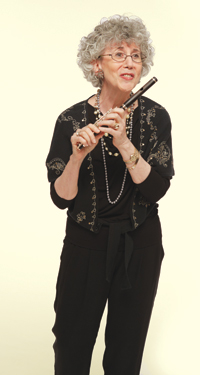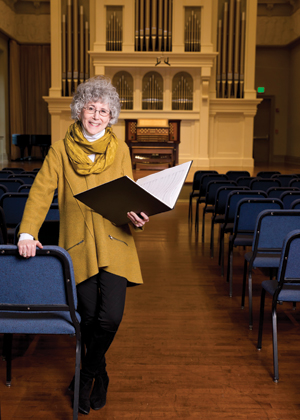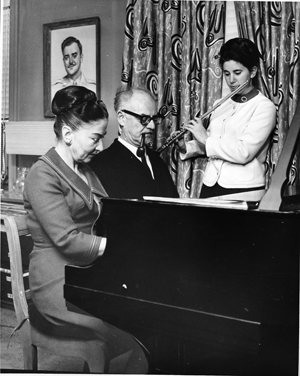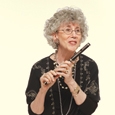photo by James Bartolomeo

Laurie Sokoloff, solo piccolo of the Baltimore Symphony and instructor at The Peabody Institute, began her professional career while still a student at The Curtis Institute playing piccolo in both opera and ballet orchestras in Philadelphia. She retires from the Baltimore Symphony Orchestra this spring after a 47-year career. Sokoloff will continue to teach at The Peabody Institute where she heads the piccolo masters degree program.
What brought you to the Baltimore Symphony?
I was invited to audition mid-season. Their piccolo player had left the orchestra suddenly, and John Krell, solo piccolo with the Philadelphia Orchestra and author of Kincaidiana, recommended me for the job. I was in the middle of a five-week tour with the Pennsylvania Ballet Company and had no orchestra parts with me other than the ballet scores we were playing. I requested the BSO have a folder of parts copied and ready for me and arrived 45 minutes before the audition so I could practice. That may be a record of sorts for the least prepared orchestral audition ever. I started with the orchestra two weeks later on February 19, 1969, rehearsing and performing Holst The Planets.
What changes have you see in your many years with the orchestra?
When I joined the orchestra, the season was only 36 weeks long. We mostly rehearsed and played in the Lyric Theater which we rented. When other shows or groups used the theater, we rehearsed at a nearby high school. We also gave performances in city schools. Times have changed dramatically since then. We still give concerts for school children, but they are brought to us. The orchestra is employed year round now and has two homes. We own and perform weekly in Baltimore at The Joseph Meyerhoff Symphony Hall, and almost all of the concerts are repeated in Bethesda at the Strathmore Music Center.
I have played for five music directors in my 47 years with the Baltimore Symphony. In 1969 Sergiu Comissiona was the appointed music director for the following season, and Englishman Brian Priestman was the designated interim music director. Priestman was jovial and energetic, with a wonderful sense of humor. Comissiona had great talent and musical sensitivity, and achieved many great performances with the orchestra. He demanded a very wide dynamic range, often repeating passages until a true pianissimo was achieved. This made for some tense times for a piccolo player. During these years I really learned how to play very, very soft, while still maintaining a lyrical sound. Comissiona was followed by David Zinman. I often refer to our years with Zinman as our Camelot. Zinman was quintessentially American – direct, honest, and concise. He preferred a lean and tight ensemble cohesiveness from the orchestra, and possessed a very clear baton technique that made great ensemble playing possible. I treasure the many performances and recordings we made with Zinman.
He was followed by Yuri Temirkanov, perhaps the greatest living interpreter of Russian repertoire. Temirkanov’s skill was so extraordinary that I would often observe him entranced – once even missing an entrance because I was so enthralled with the musical texture and phrase he was spinning. I remember the first rehearsal we had with him as music director. He was rehearsing the opening of Mahler Symphony #2. The low strings were not playing the opening to his satisfaction, and he had them repeat the passage several times, singing in between repetitions the way he wanted it. Suddenly, after five or six tries, it clicked. It was so electrifying that I actually felt the hair on my neck and arms stand up.
When Temirkanov left, there was much press about the hiring of Marin Alsop, as she was and is the first woman to direct a major American Orchestra. She has accomplished so much in her time here, especially in reaching out to the community. With her own funds she initiated a program called Orchkids bringing extended musical education to inner city schools. She also initiated the BSO Academy which invites adult amateurs to rehearse and perform with the orchestra. Personally, I am especially proud of a recording of Dvorák’s 6th Symphony made with Alsop. The piccolo only plays briefly in one movement, but the solo is fiendishly difficult to play in tune.
During my tenure in the orchestra I have been featured in performances of the Vivaldi C major Concerto, the Liebermann Piccolo Concerto and Henri Kling’s, The Elephant and The Fly. As a piccolo player, of course my favorite works are the Shostakovich Symphonies, numbers 5 through 10, for their exceptionally beautiful and lyrical piccolo solos.
Since your parents were both well-known pianists and teachers at Curtis, what led you to the flute?
My mother started teaching me piano when I was six. It did not go well. Most lessons ended in tears, as it was difficult for me to not feel in competition with her many outstanding students. Next I studied with my father’s former duo piano partner, Ralph Berkowitz. I also studied solfège every week for many years, and I am grateful for that valuable background. When Berkowitz left town several years later, I was allowed to switch to a different instrument.
I wanted to learn to play the harp, but my mother objected. She pointed out that one needed a station wagon to transport it from place to place, and that once it arrived, it was largely out of tune. My harpist friends find this amusing; admitting that at that time there was probably some truth in her assessment. Mother wanted me to play clarinet, which did not line up at all with my fantasy of sitting at a gold harp. We ultimately compromised on the flute, and William Kincaid, principal flute of the Philadelphia Orchestra and flute professor at The Curtis Institute, agreed to oversee my studies.
I worked briefly with a student at Curtis, but after six months began studies with John Krell. Since my mother doubted my motivation, and I was still somewhat disappointed about the harp, she hired two Curtis students to practice with me four days a week. This was incredibly helpful. Each session was an hour long, and I learned efficient practice techniques from the start. Between the solfège studies and these coached practice sessions, there is no doubt in my mind that I owe my mother credit for my musical career.
John Krell was an amazing teacher and a great inspiration. He stressed the importance of supporting the airstream. He would often use the tip of his flute to poke me in the diaphragm to make sure these muscles were in use. (We now know that much of what was taught about so called diaphragm support was anatomically incorrect, but the overall concepts worked.) With him I learned almost all the scales and arpeggios and one book of Andersen etudes.
He was an extraordinary piccoloist, and his performances with the Philadelphia Orchestra were legendary. He had a luscious warm flute-like tone. For many years I could always recognize a Philadelphia Orchestra recording by his sound alone. When I started to play piccolo seriously, I would beg him for a lesson. He would begrudgingly oblige, saying that it was not really possible to teach the piccolo. He would usually reiterate this view just before giving me an incredible two- or three-hour lesson. (I think what he meant was that no one had taught him how to play the piccolo, so he had to figure it all out on his own.) Despite this view, he taught me, and others, so much about playing the instrument. He shared his knowledge generously and was a constant inspiration. I also remember going to his home and being greeted so warmly by his wife. I was quite surprised to learn after she passed away, that she was a spy for the US during World War II.
After 18 months with Krell, I began lessons with William Kincaid. Since my father was his accompanist, Mr. Kincaid refused any payment for these lessons. However, my parents sent a fifth of single malt scotch with me to each lesson which he never refused.

William Kincaid, Laurie Sokoloff, and Vladimir Sokoloff
Lessons with Kincaid were very structured. He possessed a keen and analytical mind and had a scientific approach to teaching. I knew exactly what was expected each week. It was assumed I would arrive at lessons already warmed up. I was expected to zip through scales, all at the same fast tempo. In the early Andersen etudes, I prepared two for each lesson. I had begun learning the Handel Sonatas in my brief time studying with Krell, and I finished learning the rest in my initial lessons with Kincaid. I memorized them and had them all at performance level before I was allowed to tackle Bach Sonatas. He gave me his articulation markings for the Bach sonatas, and I still treasure my copy today. In my own teaching I have changed a few, but not many.
A great example of Kincaid’s analytical nature was the way he taught cadenzas, indicating exactly how many beats each note was to receive. This not only showed me how to play a cadenza but also taught me about note value ratios and how to develop phrasing and intensity. After learning all of the scales, arpeggios, and thirds and sixths, I learned the André Maquarre Daily Exercises. I was expected to memorize the C major/a minor themes, and then transpose them into all keys without looking at the music. This was wonderful ear training. Then came the Andersen Études. I was to single tongue sixteenth notes at quarter note=140 – a lofty goal that I admit I never quite achieved. He also believed in a double tongue that was indistinguishable from single tonguing, and that double and triple tonguing should be practiced at all speeds, including slowly. In most situations he recommended da and ga over ta and ka.
After Handel and Bach, we moved on to Mozart Concerti, eventually adding Poulenc Sonata, Prokofiev Sonata, Griffes Poem, Dutilleux Sonata, Nielsen Concerto and Ibert Concerto. Interspersed between these more profound works were some less serious pieces like Kent Kennan’s Night Soliloquy, Andersen’s Scherzino, Caplet’s Reverie et Petite Valse, and Robert McBride’s In The Groove. I only rarely hear these performed today, although the Kennan and Caplet remain two of my favorites.
What was it like to study at The Curtis Institute when you were only 16 years old?
In my high school sophomore year, I learned there would be several openings in Kincaid’s studio the following year. It seemed an advantageous time to audition, despite my age and only having studied for a few years. For the next several months I worked on the repertoire required for the audition: a solo of my choice, Beethoven’s Symphony No. 3, Mendelssohn’s Midsummer Night’s Dream Scherzo, and Debussy’s Afternoon of a Faun. I was elated when I was accepted, along with flutists Charles Wyatt and Peter McKinnon. Since there typically were several under-age students at the school most years, Curtis provided private tutoring. I had several high school classes by myself and loved the individual instruction.
It is embarrassing to admit but I was very underprepared my first year. I was not even totally secure with all of the fingerings in the third octave. This changed very quickly with a multitude of scales, arpeggios, Taffanel et Gaubert, Andersen Etudes, and Maquarre Daily Exercises. At The Curtis Institute we were encouraged to play recitals every year. I had the luxury of collaborating with my father at the piano.
In Philadelphia at that time there were two opera companies hiring musicians in addition to the Pennsylvania Ballet. While all the flute jobs were taken, no one wanted to play piccolo. I volunteered to fill the piccolo vacancies and found I really loved playing the instrument. John Krell referred to the piccolo as the coloratura soprano of the orchestra. I have always loved that observation and embraced the concept.

photo by Mitro Hood
Is the curriculum you studied with Kincaid at The Curtis Institute similar to what you teach at the Peabody Institute?
The curriculum at Peabody is similar with the exception of Maquarre Daily Exercises. Peabody requires familiarity with all scales and arpeggios, Taffanel et Gaubert thirds and sixths, and several Andersen etude books by the end of the first undergraduate year. I work with many types of students with different goals, so I have a variety of approaches to teaching. I am most demanding with my students at Peabody since their goals to be professional performers are the most serious. In my private teaching I adjust my style to suit each student. I have had high school students with professional goals. Some have auditioned and been accepted at Peabody with one studying with Marina Piccinini. I have also taught high school students who want to learn to play well, but as an enjoyable sideline to other future ambitions. I also work with adult amateurs who have returned to flute after a hiatus of many years. Some perform in church, some in neighborhood orchestras, and one played in a klezmer group.
A dozen years ago I initiated a program at Peabody for attaining a master’s degree in piccolo performance. Teaching piccolo is most gratifying for me as this is my main area of expertise. Additionally, all undergraduate flutists are required to take two semesters of my weekly piccolo class, and graduate students one semester. Many then decide to study piccolo for their entire time at the institute. I am so proud of our flute and piccolo students, seven of whom have won eight orchestra piccolo auditions since I began teaching at Peabody. Additionally, my piccolo master’s degree candidates have won first prize in the last two NFA Piccolo Artist Competitions. (Zach Galatis in 2012, Jenni Miller in 2014).
What tips do you have about tone or articulation on the piccolo?
Obviously everything is smaller on the piccolo. Piccolo playing requires a smaller embouchure, while still making sure the air flows freely. The aperture or opening in the lips should not be squeezed or pinched as this creates a shrill sound and makes playing soft dynamics almost impossible. Even the motion of the tongue when articulating on piccolo should be smaller, as the typical flute articulation motion results in an attack that is too percussive. These are over generalizations since, just as on flute, it is ideal to have a range of different articulation styles, as well as a palette of tone colors. Also I find the connection of the embouchure to the instrument more easily disturbed on piccolo, so players should have a smoother finger action, and keep the fingers closer to the keys.
With your busy performing and teaching schedule, how do you stay in shape?
For most of my time with the Baltimore Symphony I practiced 30 minutes in the morning and an hour in the late afternoon preparing repertoire for that week and the following one. Twenty years ago this changed when I was diagnosed with fibromyalgia, a syndrome characterized by widespread pain. Initially I was out of work for three months. This was a frightening time for me, as many experts recommended finding a different job. Playing in a symphony orchestra is so much more than a job. Fortunately by consulting others with the syndrome, I found a team of specialists with a more positive and constructive approach. I began six months of physical therapy sessions along with exercises to do at home daily. Every aspect of my life was examined and altered, from sleeping position, diet, posture, exercise, pastimes, etc. The Baltimore Symphony asked what they could do to help me get back to work for which I am eternally grateful. They provided a special chair with arms that adjusts in every direction. The BSO has transported my chair on tours, including to Europe and Asia. I also purchased a chair to have at home for practicing. I do have to limit my practice time, but I rely on the practice techniques I learned early on.
I have never had one set warmup routine. Since my practice time is now limited, I prefer to focus on playing aspects I wish to improve. So some weeks I may use the initial 15 minutes working at opening up or broadening my sound on the piccolo, whereas other weeks I may work on speeding up articulation. I enjoy the variety.
What is next after retiring from the symphony this spring?
My fiancé and I have been planning our wedding and building a new home which we plan to move into soon. I will continue to play concerts and teach at The Peabody Institute, masterclasses, and private students.
Stories About My Parents
 Eleanor Sokoloff continues to teach at The Curtis Institute at the age of 101. She took piano lessons at the Cleveland Institute of Music as a child and at age 17 began studies at The Curtis Institute in Philadelphia. Five years later she joined the Curtis faculty. More than 75 of her students have soloed with the Philadelphia Orchestra. Her students include Hugh Sung, Lambert Orkis, Marcantonio Barone, Susan Starr, Claire Huangci, Kit Armstrong, Craig Sheppard, Meng-Chieh Liu, Leon McCawley, Keith Jarrett and Sean Kennard. In 2001 in recognition of her tenure, Sokoloff received the Curtis Alumni Award.
Eleanor Sokoloff continues to teach at The Curtis Institute at the age of 101. She took piano lessons at the Cleveland Institute of Music as a child and at age 17 began studies at The Curtis Institute in Philadelphia. Five years later she joined the Curtis faculty. More than 75 of her students have soloed with the Philadelphia Orchestra. Her students include Hugh Sung, Lambert Orkis, Marcantonio Barone, Susan Starr, Claire Huangci, Kit Armstrong, Craig Sheppard, Meng-Chieh Liu, Leon McCawley, Keith Jarrett and Sean Kennard. In 2001 in recognition of her tenure, Sokoloff received the Curtis Alumni Award.
Vladimir Sokoloff, also taught on the faculty of The Curtis Institute of Music and was orchestral pianist of the Philadelphia Orchestra from 1938 to 1950. Besides playing chamber music with the Curtis String Quartet, he accompanied a who’s who of virtuoso performers including flutists William Kincaid and Julius Baker; violinists Efrem Zimbalist, Jaime Laredo and Aaron Rosand; violist William Primrose, cellists Gregor Piatigorsky and Emanuel Feuermann and soprano Marcella Sembrich. He helped found the New School in Philadelphia that later became the Ester Boyer School of Music at Temple University.
My Father and the Lost Flute
While still a student at Curtis, I came home for dinner with my family before leaving to perform the Debussy Sonata for flute, viola and harp. I left my flute and music on a boot chest by the front door. After dinner I quickly dressed for the concert and then could not find my flute and music anywhere. In a total panic, I called Mr. Kincaid. He said to stop by the front desk of his apartment, and there would be a flute and music waiting for me. When I arrived at the performance, I was shocked to see that he had loaned me his own platinum flute!
Throughout the following days, Philadelphia Orchestra members would stop me on the street to comment about my lost flute, a tale my father had shared with them much to my embarrassment. The next week my dad disappeared for a while during dinner. He often did this because he was unhappy that the trash collectors would not take everything he set out. To circumvent this, he would listen for the truck and personally hand them the trash.
On this occasion, however, he was absent longer than usual. When he finally returned to the dinner table, he placed my flute and music in front of me. Apparently the week before he had placed a bundle of trash on the boot chest, unaware that my flute was underneath. When he handed the trash over, he also gave them my flute. Fortunately, the following week the trash collector asked my dad if he really had intended to discard the instrument and even made a special trip home to retrieve it. The funniest part of the story was that the following week, Philadelphia orchestra members again stopped me on the street to relate that they heard my father had found and rescued my flute. Apparently he never mentioned he was the one who threw it out.
My Mother
I speak with my mother almost every day. She has shared many interesting tidbits about their early musical life. Recently she told me stories of a summer spent at Tanglewood, where apparently my father frequently went swimming with Leonard Bernstein. At concerts my parents routinely sat in Bernstein’s box seats, and on one such occasion my mother said they sat with a famous German composer, whose name she could not recall. She urged me to help her figure out his name and kept saying he was famous, but she thought mediocre. Since this covered a lot of territory, I was unable to supply the correct name until she added that my father and I had performed his sonata for flute and piano many times. My jaw dropped and I asked hesitantly, “Hindemith?” “Yes, yes, that’s him,” she replied. I cannot decide which is more surprising – that my parents knew Hindemith or that my mother considered him a mediocre composer.
My mother had a very full teaching schedule. She taught six days a week, most days going from 10 am until 6 pm in the evening without a break – eating lunch at the piano. There was not much sound proofing in our home, so I grew up hearing piano music almost all the time. I know every note of the major piano repertoire although I do not always know the name of the composer since no one shouted up to my room the repertoire information. I was incredibly lucky to grow up hearing music tastefully and beautifully played.
* * *
Laurie Sokoloff has played piccolo in the Baltimore Symphony Orchestra since 1969. She also teaches flute and piccolo at The Peabody Institute, a division of Johns Hopkins. This summer she will lead the Piccolo Division of the Marina Piccinini International Summer Flute Masterclasses May 27-June 1, 2016 at the Peabody Conservatory. Sokoloff has served as the chairperson of the National Flute Association Piccolo Committee and Coordinator of their Piccolo Artist Competition. She premiered Michael Daugherty’s The High and the Mighty for piccolo and piano at the 2000 NFA Convention. Sokoloff is a graduate of The Curtis Institute where she studied with William Kincaid, legendary principal flutist of the Philadelphia Orchestra.






